Dutch Iris (Iris x hollandica) for the Farmer Florist
Dutch Iris (Iris x hollandica) for the Farmer Florist
The iris is one of the most famous flowers depicted in art, perhaps second only to the iconic rose. With availability in many colors, it is no surprise that Iris is the name of the Greek goddess of the rainbow. The many colors and elegance of the flower have led it to be associated with royalty throughout history. The most famous use of the iris was its adaptation on the royal banners of the Bourbon dynasty in France. This adaptation, commonly referred to as the fleur-de-lis, is a three-sectioned symbol that depicts a cross-section of an iris flower. Today, the fleur-de-lis has been adopted as the unofficial symbol of New Orleans.
Know Your Irises
Iris flowers come in a range of colors, including blue, yellow, purple, bronze, rose, and gold. They can be found growing on nearly every continent. There are more than 200 species of irises that are separated into two major groups: rhizomatous or bulbous.
Rhizomatous irises have underground stems called rhizomes that store food produced by the leaves. Each year, rhizomes give rise to offshoots that may be divided and transplanted, producing new irises. Popular rhizomatous iris species include the Siberian, Spuria, Japanese, African, Californian, German, and Louisiana. Their flowers are typically ephemeral, lasting only about 1 day in vase arrangements.
Unlike rhizomatous irises, bulbous irises are grown from bulbs. Their flowers last about 3–5 days. Like rhizomes, bulbs are modified, plate-like stems surrounded by cylindrical leaves, with the growing point emerging from the top of the plate. Bulbous irises are divided into two subgroups: Xiphium and Scorpiris. Irises belonging to the Xiphium subgroup are rootless during the resting, or dormancy, stage and include the Dutch, Spanish, and English varieties. Members of the Scorpius subgroup contain thick, fleshy roots during the resting stage and include the Juno iris.
Dutch Iris Production
Dutch irises are bulbous. When purchasing bulbs, make sure you choose a reputable supplier to avoid low-quality bulbs. Like tulips, bulb size correlates to flower size, so choose the largest bulbs available.
Since Dutch irises flower in the spring, their bulbs should be planted in the fall. For best results, plant the bulbs within a month of receiving them from the supplier. If you must store bulbs before planting, keep them in a cool (50–70°F), dry area away from direct sunlight.
To ensure an ample supply of cut stems to use over time, plant bulbs in beds successively, at 7- to 14-day intervals. You can treat Dutch iris as an annual plant and plant new bulbs every fall.
Cultural Practices
Dutch irises prefer well-drained soil. When planting in areas with poor drainage, mix organic matter (compost, manure, or composted pine bark) into the soil to increase the drainage. Plant bulbs in an area that receives full sun, but they can tolerate a bit of afternoon shade, especially in areas at the warmer end of the hardiness range. Flower quality can begin to suffer in areas without full sun.
Dutch irises are hardy plants and do not require excessive amounts of nutrition to produce flowers. It is always good practice to monitor the soil fertility with a soil test. Contact your local Extension office to learn about this worthwhile process. Fertilize plants with a 5-10-5 fertilizer three times a year: at fall planting to encourage root formation, in the spring after emergence to feed foliage growth, and after harvest to prepare the bulb for dormancy. If you decide to replant fresh bulbs every fall, only two fertilizer applications are needed.
When used as a cut flower, producers in the Netherlands recommend planting bulbs 4 inches deep and 4 inches apart to maximize the number of harvestable flowers in the production area. This amounts to roughly four bulbs per 16 square inches. Plant rows of Dutch iris bulbs 18–24 inches apart. Many commercial producers use closer spacing to maximize yields, placing bulbs side by side.
During floral development, irises need to be watered approximately every week depending on the growing environment. Thoroughly soak the soil, and do not water again until the soil is dry. They respond well to drip irrigation. Irises are susceptible to disease problems in wet or poorly drained soils.
Insects and Diseases
Dutch irises are generally insect- and pest-free; however, poorly drained soils contribute to disease problems. Iris leaf spot is the most common and widespread disease encountered in production. The fungal pathogen (Mycosphaerella macrospora) thrives in areas of prolonged mild and very damp weather. The first stage of the disease begins as green, water-soaked areas that soon dry and turn brown. In severe cases, leaf spot causes leaf dieback and can ultimately lead to the death of the entire plant.
Good cultural and sanitation practices will help to prevent leaf spot. It is important to remove and destroy the infected parts of the leaves as soon as the disease begins to develop. When removing diseased plant tissues, sanitize tools to prevent spreading the disease between plants. Collect and dispose of infected plant debris in the fall. If cultural practices fail to keep the disease in check, fungicide treatments have been reported to be effective.
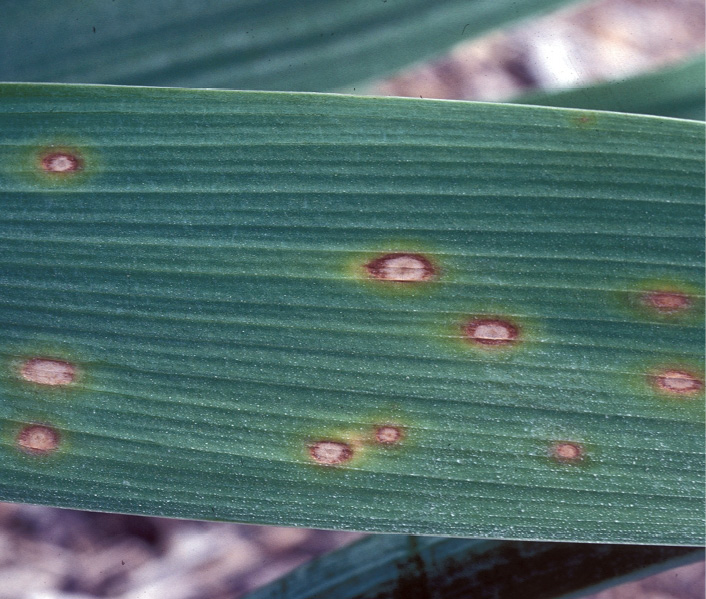
Harvest and Post-Harvest Handling
Harvest irises in the pencil stage, when roughly half an inch of the colored tip is visible. Pull the entire plant from the soil, including the bulb. Remove the bulbs as well as any yellow or disfigured foliage. Sort the stems according to their length and uniformity, and bundle them into groups of 10. Discard the bulbs.
After harvesting, place iris stems upright into a cooler set at 33–35°F (0.5–1.7°C) to prevent dehydration. Do not store stems for more than a week because prolonged storage can result in the flowers failing to open. If flowers
start to dehydrate, place them into a bucket of water with flower food to rehydrate them.
Iris flowers are not sensitive to ethylene, a naturally occurring plant hormone that ages cut flowers. No special steps are needed (ethylene scrubbers or separate storage areas) to prevent ethylene damage. Commercially grown irises are sold in 10-stem bunches and are packed into cardboard boxes and shipped. Their vase life may be shorter than other cut flowers, between 2 and 5 days; however, floral food can extend the vase life to a week.
Design Applications
Dutch Iris in a Wooden Planter Box
The growth habit of Dutch irises suggests their arrangement into compositions with strong, vertical lines. To create this floral arrangement, we used about 20 stems of Dutch iris ‘Silvery Beauty’. We hydrated fresh flower foam and placed it into a wooden window box, which we lined with thick plastic sheeting. We cut the iris stems at slightly different heights to display their blooms with minimal overlapping. This technique provides a greater presentation of the irises’ blue color. We completed the base of the design by impaling short boxwood cuttings into the floral foam. This foliage does not compete with the slender iris stems but merely covers the non-decorative floral foam. As always, add fresh flower food solution to the container.
This style of arrangement can be used in multiple settings, including church altars and reception buffets. A pair of these arrangements could flank the wedding altar. They could also be displayed in the middle of a buffet table without interfering with serving platters. It is a good option to consider for customers who want to move the floral designs from the wedding ceremony to the party gathering.
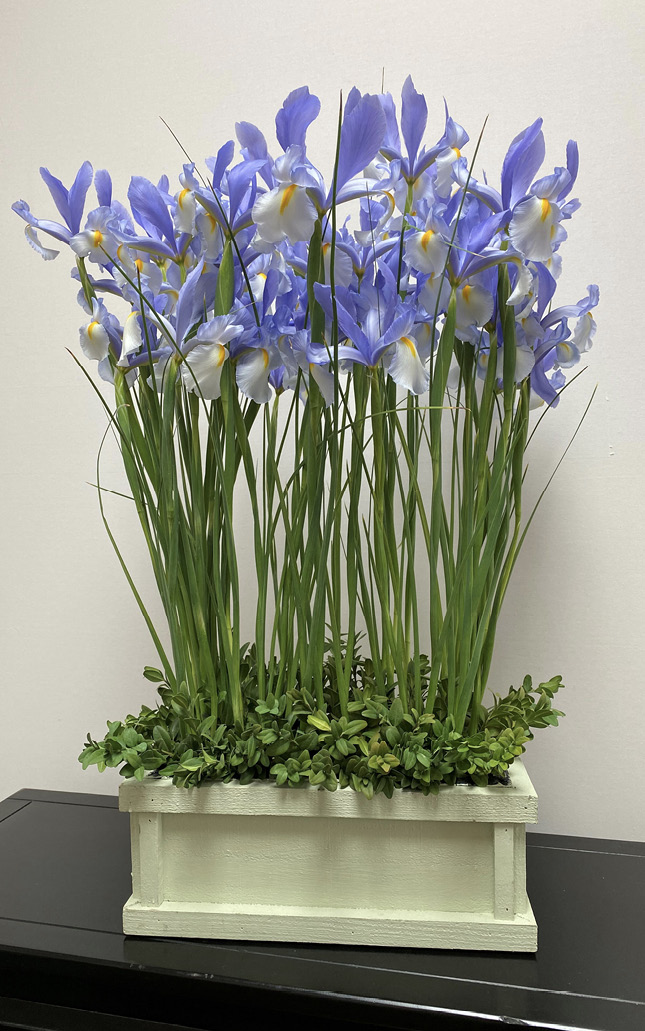
Asian-Inspired Dutch Iris Centerpiece
While our altar arrangement used several stems of flowers, this table centerpiece design uses just three. We were inspired by the distinctive form of these Dutch irises to maintain open space around the flowers yet use them at nearly their full length. Much of this cut flower’s value is found in the length of its stems. A lichen-covered twig and a stripped stem of foxtail fern (Asparagus densiflorus ‘Myerii’) extend from the container’s base. This is an example of harmony in floral design—the combination of varying materials to create a finished design that is greater than the sum of its parts.
We made a small nest of Spanish moss (Tillandsdia usenoides) and anchored it into the floral foam using 20-gauge wire pins. A few artificial robin eggs complete the design’s base. Three votive candles suggest this combination as a table centerpiece suitable for an after-6-o’clock event.
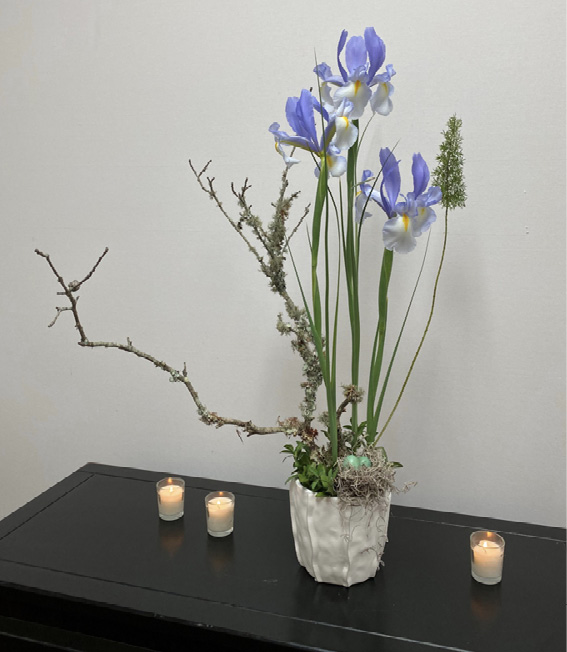
Dutch Iris Nosegay
Dutch irises can be used in masses, concentrating their color rather than focusing attention on their distinctive form. We created this bridesmaid’s nosegay bouquet using the wired-and-taped method. We mounted approximately six ‘Silvery Beauty’ Dutch irises on 24-gauge wires, then taped them with stem wrap. We created a bow with #9 sheer, nylon ribbon in sky blue, then arranged the wired irises into the ribbon. You can add additional foliage to the design as well as ribbon streamers.
This simple design has a spontaneous effect, and its design time is relatively quick. Once completed, thoroughly mist it with an anti-transpirant solution, allow the surfaces to dry, and package it in a plastic bag. Do not allow the plastic film to rest on the petals because this may allow gray mold to proliferate. Store the bagged bouquet in refrigeration. It can remain fresh for up to 3 days and still provide adequate display time for a wedding or event.
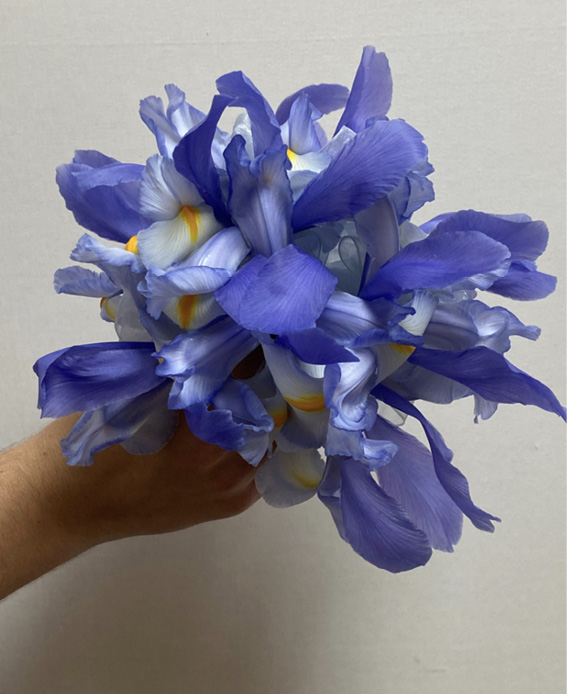
For the following design applications, it is helpful to know the parts of the iris flower.
Dutch Iris Composite Flower
Dutch irises can be used for advanced floral design work such as this example of a composite flower. In floristry, a composite flower is a flower made from multiple petals or leaves. We used a Styrofoam egg for the base of this composite, with a handle made from a silk flower stem glued into its base. We removed individual iris petals from entire flowers and arranged them into groups according to standards, style arms, and falls.
We used florist cold glue to adhere all flower parts to the egg. Begin the gluing process by layering standard petals at the top of the egg. Add the glue to the petals and allow it to become tacky before adhering them to the egg. Take care to allow the glue to dry slightly; otherwise, it will burn the plant tissues, leaving unsightly marks.
Next, we added a layer of style arms. Their cupped shapes help fill in the gaps and conform to the egg. The third layer consists of multiple falls displaying their showy, golden signals. We glued a lightweight driftwood segment to the base of the egg and stem to act as a bouquet handle, then added multiple coats of anti-transpirant spray.
A design like this could be used for a bride, mother of the bride, or bridesmaid. It could also be carried at proms and pageants. Continued practice can help you achieve high-quality designs, so invest some of your Dutch iris stems toward composite flower construction.
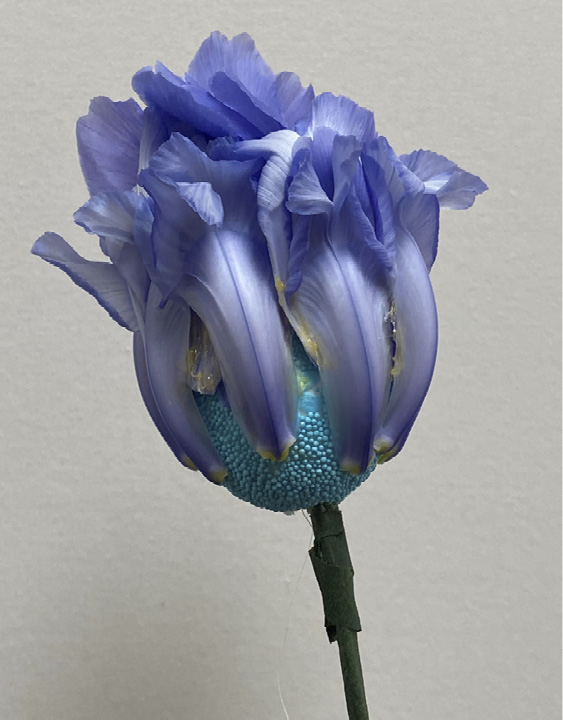
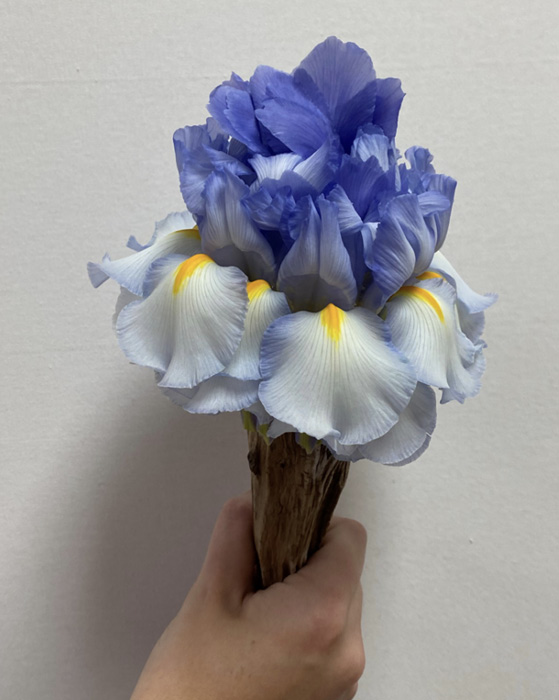
Pocket Square
Grooms, groomsmen, prom attendees, or anyone wearing a jacket with a breast pocket can opt for a pocket square rather than a boutonniere as a distinguished accent to a suit or tuxedo. We purchased flexible plastic placemats and cut them to fit in a breast pocket. Some florists use cardboard for this purpose and glue ribbon around the segment for a professional finish. We used cold glue to adhere both the green horse tails (Equisetum hyemale) and Dutch iris petals in place.
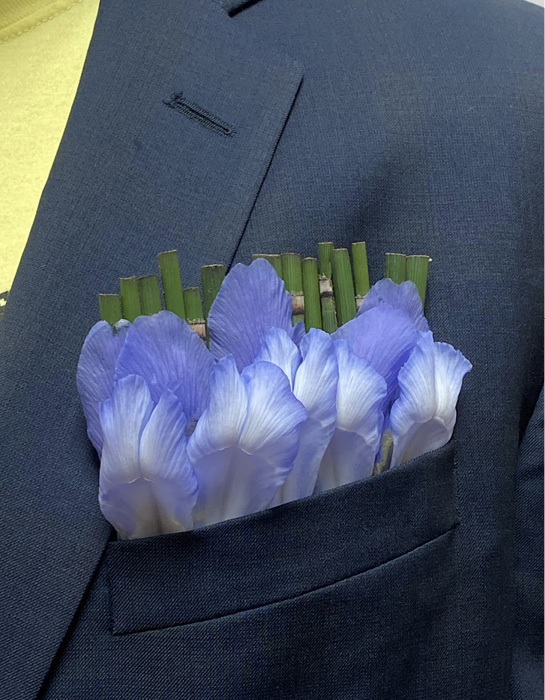
Farmer florists are encouraged to experiment with standards, style arms, and falls for varying effects in pocket square designs. Note that parts of the iris flower, particularly falls, are fragile. One hug can crease or even smash these designs, so it is best to wear them just for photographs. Another option is to create multiple replicas to replace as needed.
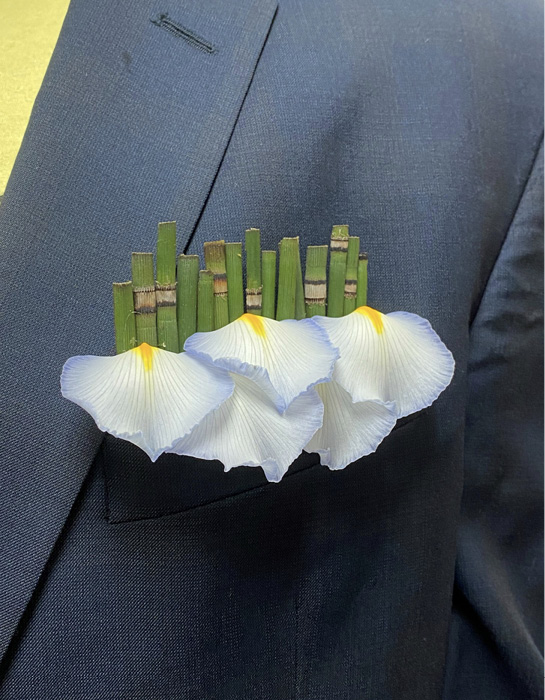
Acknowledgments
Davis Mills of The Nature of Things in Courtland, Mississippi, designed, manufactured, and provided the window box container used in this publication.
We wish to thank Alena Anderson and Matthew Jargowsky for their assistance.
References
All about irises. (2021). American Meadows. Retrieved January 28, 2022
Armitage, A., & Laushman, J. (2003). Specialty cut flowers: The production of annuals, perennials, bulbs, and woody plants for fresh and dried cut flowers (2nd ed.). Timber Press.
Butler, S., DelPrince, J., Fowler, C., Gilliam, H., Johnson, J., McKinley, W., Money-Collins, H., Moss, L., Murray, P., Pamper, K., Scace, P., Shelton, F., Verheijen, A., & Whalen, K. (2005). The AIFD guide to floral design. Intelvid.
Dole, J., & Wilkins, H. (2005). Floriculture: Principles and species (2nd ed.). Pearson.
All about iris. (n.d.) Longfield Gardens. Retrieved January 28, 2022
Iris. (n.d.). Missouri Botanical Garden. Retrieved January 28, 2022
Pataky, N. R. (1982). Iris leaf spot. University of Illinois Extension Service RPD No. 628.
Reid, M. S. (2004). Iris, fleur de lis. University of California Postharvest Center.
The information given here is for educational purposes only. References to commercial products, trade names, or suppliers are made with the understanding that no endorsement is implied and that no discrimination against other products or suppliers is intended.
Publication 3740 (POD-02-22)
By Anthony Bowden, Research Associate, South Mississippi Branch Experiment Station; James M. DelPrince, PhD, AIFD, PFCI, Associate Extension Professor, Coastal Research and Extension Center; and Patricia Knight, PhD, Research Professor and Director of Coastal Horticulture Research.
The Mississippi State University Extension Service is working to ensure all web content is accessible to all users. If you need assistance accessing any of our content, please email the webteam or call 662-325-2262.


